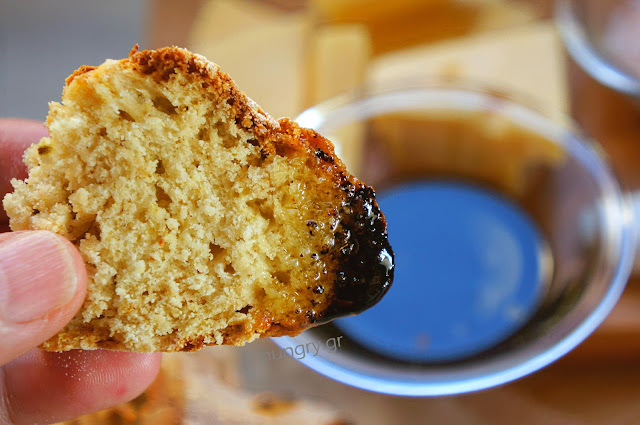
A loaf of Irish soda bread is a traditional bread, prepared with an old technique, to get half an hour of a very tasty fluffy, and simple processes bread at our table, ready to be eaten warm, with lots of crumbs but quite crunchy crust.
The Kitchen Stories continue to create and pass in your own kitchen wonderful culinary sorcery. Follow these simple steps and make delicious hearty bread in half a shake!
Flour, buttermilk, baking soda and spices, which will wonderfully flavor it.
Yours!
The Kitchen Stories continue to create and pass in your own kitchen wonderful culinary sorcery. Follow these simple steps and make delicious hearty bread in half a shake!
Flour, buttermilk, baking soda and spices, which will wonderfully flavor it.
Yours!
| work: 5′ | time: 30′ | very easy: |


Traditional Irish Soda Bread
 Soda Bread
(Ιρλανδικά: Arán sóide, Σκωτσέζικα: fardel, Σερβικά: česnica / чесница) is a variety of quick bread traditionally made in a variety of cuisines in which sodium bicarbonate (otherwise known as baking soda) is used as a leavening agent instead of the more common yeast. The ingredients of traditional soda bread are flour, bread soda, salt, and buttermilk. The buttermilk in the dough contains lactic acid, which reacts with the baking soda to form tiny bubbles of carbon dioxide. Other ingredients can be added such as butter, egg, raisins, or nuts.
Soda Bread
(Ιρλανδικά: Arán sóide, Σκωτσέζικα: fardel, Σερβικά: česnica / чесница) is a variety of quick bread traditionally made in a variety of cuisines in which sodium bicarbonate (otherwise known as baking soda) is used as a leavening agent instead of the more common yeast. The ingredients of traditional soda bread are flour, bread soda, salt, and buttermilk. The buttermilk in the dough contains lactic acid, which reacts with the baking soda to form tiny bubbles of carbon dioxide. Other ingredients can be added such as butter, egg, raisins, or nuts.Origin: During the early years of European settlement of the Americas, settlers and some groups of Indigenous peoples of the Americas used soda or pearl ash, more commonly known as potash (pot ash) or potassium carbonate, as a leavening agent (the forerunner to baking soda) in quick breads. In the US, soda breads were first publicised by Amelia Simmons as a quick and cheap method of bread making in her book American Cookery, published in 1796. By 1824, The Virginia Housewife by Mary Randolph was published containing a recipe for Soda Cake.
In Europe, soda breads began to appear in the mid-19th century when bicarbonate of soda first became available for use as a raising agent. Breads, griddle cakes and scones with bicarbonate of soda and cream of tartar or tartaric acid became popular in Austria, Polish cuisine, Britain and Ireland. Traditional soda bread, eaten in Serbian cuisine, also uses bicarbonate of soda, particularly the traditional česnica (Serbian Cyrillic: Чесница), a soda bread made at Christmas.
Ireland: Home irish soda bread. In Ireland, the flour is typically made from soft wheat; so soda bread is best made with a cake or pastry flour (made from soft wheat), which has lower levels of gluten than a bread flour. In some recipes, the buttermilk is replaced by live yogurt or even stout. Bakers recommend the minimum amount of mixing of the ingredients before baking; the dough should not be kneaded.

Ingredients (1 loaf)
|

In a bowl sift the flour with the baking soda and salt. Create a puddle in the flour and pour the oil and then the buttermilk. Stir the mixture with a spoon. |

Add the spices and stir very gently to combine ingredients of the dough. It will be a fairly sticky dough. |

Pour the dough on lightly floured work surface. Knead for 1'-2' and form a ball of dough slightly flattened Ø13-15cm (Ø5.1 - 5.9in). Don not over knead. |

You scribe deeply on the surface of the dough ball a cross. |

Bake at 180°C (356°F, Gas:4.2) for 25′ or until risen and get a golden color. When hit with our palm, underneath will make a muffled sound. Ready. |


★If we do not have buttermilk, stir vigorously an equal amount of milk with 2-3 tablespoons fresh lemon juice. Leave aside to sit for 10′ before use.
Author Zambia G. Sifaki

